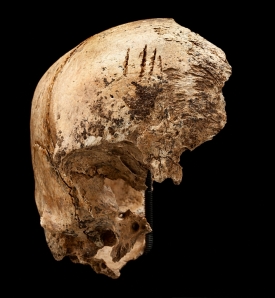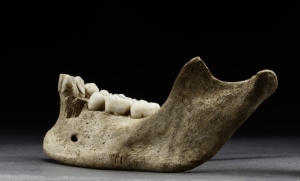Blog Archives
Archaeology, Human Dignity, and the Fascination of Death

An archaeologist excavates a casket lid from the Mississippi State Asylum (image from University of Mississippi Medical Center Public Affairs)
In 1855 the Mississippi State Lunatic Asylum opened, and by the time it moved in 1935 thousands of patients had been buried on the hospital grounds. The Mississippi asylum’s story is by no means unique: A vast range of mentally ill, developmentally delayed, and chronically ill Americans found themselves captive in dehumanizing institutions, lost to desperate and distant families and unceremoniously buried by the state. Much of archaeology’s mortuary landscape is peopled with similar lives that ended in asylums, battlefields, slave quarters, distant workplaces, prisons, and long-forgotten cemeteries.
At its best, archaeology dignifies these lives by treating their stories and forlorn remains with scientific rigor and moral respect. When the University of Mississippi took aim on the former asylum grounds Mississippi State University’s Nicholas Hermann led a team that surveyed the site to document and preserve the scores of dead patients now consigned to unmarked graves alongside the contemporary Medical Center. It is this moral notion of dignity that was violated by National Geographic Channel International’s “Nazi War Diggers,” which released (and then retracted) a promotional video last week on the four-episode series documenting the recovery of wartime dead who “lie rotting under World War Two’s Eastern Front.” This week the channel abruptly placed the series on “indefinite” delay (and removed all traces of it from their web page), awkwardly acknowledging that it was reviewing the series “while questions raised in recent days regarding accusations about the program can be properly reviewed.” Read the rest of this entry
Sympathy for the Cannibal: Archaeology, Emotion, and Cannibalism

A reconstruction of the cannibalized teen girl referred to as “Jane” (image Studio EIS photo by Don Hurlbert, Smithsonian).
Today the Jamestown Rediscovery Project reported on the archaeology of a teen girl who was apparently butchered and consumed by fellow colonists in the winter of 1609-1610. Most of the instant press coverage revolves around the evidence that the body was butchered, with mandible cut marks and skull fragmentation reflecting a somewhat clumsy dismemberment of the body during a winter in which about 80% of the settlement’s residents died. Our collective fascination with this girl’s fate obliquely humanizes her even as we paint a sympathetic if uneasy picture of the fellow settlers who cannibalized her. The story of “Jane,” as Jamestown refers to her, paints the emotional incomprehensibility of human nature while simultaneously rationalizing the desperation that would have led these first settlers to consume one of their own number.
Cannibalism holds a powerful grip on human imagination for perfectly understandable reasons: to consume another human’s body is nearly always constructed as one of the most universal of all violations, driven only by absolutely total desperation, radical ritual, or simple tragic madness. Cannibals have been a staple of popular discourse for much of the colonial period, but the specter of the cannibal was routinely invoked as an ideological caricature of colonial peoples. William Arens’ 1979 study The Man-Eating Myth was a skeptical reaction against the ideological weight of cannibal narratives, with Arens rejecting nearly all accounts of cannibalism in virtually any time and place. Cannibalism certainly has been wielded to stigmatize various colonial “Others,” and contemporary uneasiness with cannibalism has led most scholars to be circumspect about the subject. Yet a wave of archaeologists have argued quite persuasively that the aversion to acknowledging cannibalism ignores quite significant evidence for it. Compelling examples reach back over 780,000 years ago at the Spanish site Gran Dolina; 100,000 year-old Neandertal remains at Moula-Guercy were clearly cannibalized; Walter Hough’s 1901 claim for Anasazi cannibalism is accepted by many contemporary scholars; the Colorado site Cowboy Wash dates to AD 1150-1175 and has been interpreted by one team as containing human fecal remains (coprolites) with identifiable human tissue remains alongside tools with human blood residues and bones suggesting cannibalism; and in winter 1846-1847 the well-known Donner party consumed members of their group when stranded in the Sierra Nevada mountains.

Four chop marks on the top of the skull suggest other colonists were attempting to open the cranium (image Don Hurlbert, Smithsonian)
Armed with the mangled remains of this anonymous young woman and a historical case for such desperation, the Jamestown case weaves an exceptionally compelling human narrative. Archaeological narratives about cannibalism typically redeem the victims, humanizing them in the face of an unutterable end and providing an articulate narrative that rationalizes or tries to explain their death. That rationalization often finds a motivating force for cannibalizing another person, such as starvation, a move that obliquely redeems the cannibals as well as the victims. Jamestown ReDiscovery, for instance, refers to this girl’s remains as the earliest evidence of “survival cannibalism” in the colonial New World, eager to underscore that this cannibalism was driven by utter desperation. The team’s Scott Whitaker is one of the team scholars who march through a precise and persuasive forensic analysis of the skeletal evidence, focusing on Jane’s death as a scientifically analyzed process.
Such a rhetorical maneuver tends to evade the emotional incomprehensibility of consuming a human, which may in fact be our fundamental curiosity about such a fringe practice. The image of the young woman’s skull and awkward cut marks used to open her cranial vault push the limits of rationality for many us and may be a dimension of the girl’s story that archaeological rationality simply cannot resolve. However, archaeology can address the mechanics of dismemberment, and in the Jamestown case the skeleton is somewhat ineptly butchered and tends to reinforce the Jamestown assessment of this as the depths of desperation.
The story of this girl is part of the Smithsonian exhibit Written in Bone: Forensic Files of the Seventeenth-Century Chesapeake, and her death makes a compelling archaeological narrative that may show how the discipline shares its findings. The team at Jamestown has honed their skills sharing such stories in a wave of fascinating YouTube videos and well-timed press releases in advance of the Smithsonian exhibition. The Jamestown press releases feature a facial reconstruction of the cannibalized girl, a method that has little genuine scholarly purpose but is an alluring vehicle for imagination in a museum gallery or a mass media article.
The line between circumspectly tapping into collective fascination and skirting the professional review process can be problematic. For instance, a 2000 American Antiquity paper by Kurt E. Dongoske, Debra L. Martin and T. J. Ferguson scolded a team at Cowboy Wash for publishing their findings in the popular Discover magazine under the title “American Cannibals” prior to having the data peer-reviewed. The team at Leicester University was criticized in some circles for likewise failing to present their findings on the Richard III excavation in peer-reviewed scholarship before orchestrating a internationally covered news conference. Jamestown’s press included such hyperbole as the Daily News‘ headline “Cannibal Colonists!: Remains at Jamestown show early American settlers ate each other” and Vanity Fair‘s snarky headline “Cannibalism at Jamestown is Most Interesting Thing to Happen at Colony since A.P. U.S. History Trip.”
There is perhaps good reason to sympathize with the settlers who consumed this dead young woman in a moment of “survival cannibalism.” Yet cannibalism resides at the boundaries of human experience, attracting our fascination even in the face of Jamestown’s picture of the colony’s true desperation. We cannot articulate that fascination in especially settled forms, so much of what this and other archaeologies of cannibalism do is provide a firm mirror into the vast breadth of human nature.
References
William Arens
1979 The Man-Eating Myth: Anthropology and Anthropophagy. Oxford University Press, New York.
Alban Defleur, Tim White, Patricia Valensi, Ludovic Slimak, and Évelyne Crégut-Bonnoure
1999 Neanderthal Cannibalism at, Ardèche, France. Science 286(5437):128-131.
Kelly J. Dixon, Shannon A. Novak, Gwen Robbins, Julie M. Schablitsky, G. Richard Scott and Guy L. Tasa
2010 “Men, Women, and Children Starving”: Archaeology of the Donner Family Camp. American Antiquity 75(3):627-656.
Kurt E. Dongoske, Debra L. Martin and T. J. Ferguson
2000 Critique of the Claim of Cannibalism at Cowboy Wash. American Antiquity 65(1):179-190.
Fernández-Jalvo, Yolanda, J. C. Díez, Isabel Cáceres, and Jordi Rosell
1999 Human cannibalism in the Early Pleistocene of Europe (Gran Dolina, Sierra de Atapuerca, Burgos, Spain). Journal of Human Evolution 37(3-4):591-622.
Michael Harner
1977 The Ecological Basis for Aztec Sacrifice. American Ethnologist 4(1):117-135
Rachel B. Herrmann
2011 The “tragicall historie”: Cannibalism and Abundance in Colonial Jamestown. William and Mary Quarterly 3rd series 68(1):47-74.
J. S. Kidd
1988 Scholarly Excess and Journalistic Restraint in the Popular Treatment of Cannibalism. Social Studies of Science 18(4):749-754.
Patricia M. Lambert, Banks L. Leonard, Brian R. Billman, Richard A. Marlar, Margaret E. Newman and Karl J. Reinhard
2000 Response to Critique of the Claim of Cannibalism at Cowboy Wash. American Antiquity 65(2):397-406.
Richard A. Marlar, Banks L. Leonard, Brian R. Billman, Patricia M. Lambert, and Jennifer E. Marlar
2000 Biochemical evidence of cannibalism at a prehistoric Puebloan site in southwestern Colorado. Nature 407:74-78.
Timothy Taylor
2001 The Edible Dead. British Archaeology 59
Christy G. Turner, II and Jacqueline A. Turner
1992 The First Claim for Cannibalism in the Southwest: Walter Hough’s 1901 Discovery at Canyon Butte Ruin 3, Northeastern Arizona. American Antiquity 57(4):661-682.
Images
Facial reconstruction image from StudioEIS; Photo: Don Hurlbert, Smithsonian
Mandible with cuts image from Don Hurlbert, Smithsonian
Skull with cut marks image from Don Hurlbert, Smithsonian


